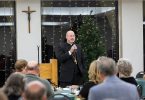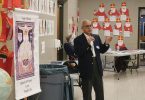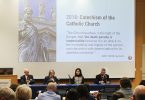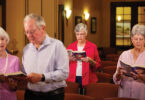by Joe Bollig
joe.bollig@theleaven.org
Maybe you promised yourself that this would be the Best Lent Ever. And so you’ve done it all: the ashes and reconciliation, fasting and abstinence, rosaries and Stations of the Cross. Your Rice Bowl is already halfway full, and you’ve even gone to the parish fish fry.
Or maybe thusfar, you’ve done nothing at all — and now Easter is just around the corner. Is it too late to make a meaningful Lent?
Fortunately, it’s never too late to work on your relationship with God. And one time-honored way requires nothing more than a few minutes a day, a quiet place, and some sacred Scripture.
Welcome into your life — and your Lent — a practice called lectio divina.
A time spent with God
“Lectio divina literally means ‘divine’ (or ‘sacred’) ‘reading,’” explained Father Jim Martin, SJ, author and culture editor of America magazine.
“It’s an ancient technique of prayer most closely affiliated with monastic communities, although it was certainly practiced before that,” he continued. “It essentially uses Scripture as the basis for prayer.”
While not specifically a Lenten devotion, lectio divina can add a new level of intimacy with Christ and love of Scripture, said Father Jim. And Lent is a great time to take it up.
“Prayer reveals things to us about God, ourselves, and our relationship with God,” he said. “It’s important to have some one-on-one time with God, such as with lectio divina.”
In its traditional form, lectio divina is comprised of four parts: lectio (reading), meditatio (thinking it over), oratio (prayer) and contemplatio (a simple, loving focus on God).
“As with a lot of different prayers, there are modifications, but this is the basic form,” he said. “People may spend more time on one part than another.” Father Jim, however, advised practitioners to add four questions to the process — one for each of the traditional four steps.
For example, after having completed the first step by reading the Scripture passage, he suggested we ask ourselves: “What does the text say?”
“Pick a text and look at the story,” he said. “Make sure you understand what’s happening in the Scripture passage. Make sure you understand the words and the historical context.”
Next, during step two, or meditation, follow up silent reflection with the question: “What does this text say to me?”
“So when I read a Scripture passage about Jesus preaching in the synagogue and speaking the words of Isaiah, I ask, ‘What do I feel,’ or, ‘What insights, emotions or memories come to mind?’” said Father Jim. “And can I understand these feelings as God speaking to me through the text?”
Step three’s “prayer,” he said, need not be the traditional prayers we say by rote. Instead, Father Jim suggests we ask: “What do I want to say to God?”
“For example, for that text of Jesus in the synagogue, I might say to God, ‘I want to be prophetic like Jesus; I want to stand up for the poor like Jesus did,’” said Father Jim. “Once again, you see that desire revealed through the text as a sign of God’s communication to you.”
Finally, said Father Jim, he likes to make step four less about contemplation and more about action, asking: “What difference will this make in my life?”
“If you say to God, ‘I want to be prophetic,’ will you actually do that?” he said. “Will you actually stand up for the poor or people who have been treated poorly?”
Two simple approaches
Another enthusiastic proponent of lectio divina is Father Thomas Keating, a Trappist monk at St. Benedict Abbey in Snowmass, Colo., said Benedictine Sister Micaela Randolph of Mount St. Scholastic Monastery in Atchison.
According to Father Thomas, the classical practice of lectio divina can be divided into two forms: scholastic and monastic.
“A form many people use today is called the scholastic form,” said Sister Micaela. “It was developed in the Middle Ages, and [it] has a tendency to compartmentalize the spiritual life and rely more on rational analysis. . . . Small groups of people studying the Scriptures use the scholastic form.”
The steps utilized by the scholastic form are the same traditional four steps outlined by Father Jim. However, the second, or monastic, form of lectio divina is actually the older form and is more often used by individuals.
In this form, Father Thomas likes to speak of “moments” rather than steps.
“Instead of those four steps, [Father Thomas] talks about four ‘moments’ along the circumference of a circle,” said Sister Micaela. “He calls those four moments ‘Reading, Ruminating, Responding, and Resting.’”
“You move along these moments according to the inspiration of the Holy Spirit,” she continued. “The Holy Spirit guides you through this. You’re ruminating on the word — chewing it, tasting it, making it part of your very being. That’s why it becomes a way of life. It, hopefully, spills over into our everyday life and helps us to live in the present moment, where God is.”
The danger in simply reading the Scripture is that we might be satisfied with a superficial encounter, she said, and not allow the Scripture to really pierce us and change us. The great thing about lectio divina is that it opens up the love of God that is contained within and helps us to be transformed.
“We read the Scriptures to meet the Lord,” said Sister Micaela. “Just to say, ‘I’ve read the Scriptures,’ without openness and vulnerability, is not [letting it be] as good as it could be.”
Consistency and flexibility
Practitioners of lectio divina emphasize taking a consistent approach: praying at the same time and in the same place every day. That said, there is a tremendous amount of flexibility in the devotion.
“The important point is to find a method that you’re comfortable with, and that works for you,” said Father Jim. “God meets you where you are. If you’re more comfortable in an easy chair, that’s OK.”
“If you’re more comfortable sitting on a cushion or kneeling, that’s terrific,” he continued. “Light a candle, terrific. Or if you just want to walk around, terrific. There are as many ways of prayer as there are personalities. There is no right or wrong way to pray.”
People trying the practice for the first time should not be dismayed if what “happens” during the time set aside for prayer doesn’t fit their preconceptions of what should happen, he said.
Usually, a lot of thoughts, emotions, insights, desires and memories are stirred up during prayer, said Father Jim. People should trust that God is using these as ways to speak to them.
And even genuine distractions shouldn’t be cause for discouragement.
“I think it’s important to try to be as aware and attentive as possible to God in prayer,” said Father Jim. “But as humans, distractions are inevitable. I think what is important is to try to move past the distractions as far as possible.”
“But if that’s not possible — to be completely focused — remind yourself that you can be with God and be distracted,” he added. “You say, ‘Here I am, Lord, and I’m preoccupied, but I want to be with you anyway.’ Also, sometimes those distractions are signs of things God wants you to think about.”
For people with families and busy lives, said Sister Micaela, meditative prayer might seem an impossibility.
But just 10 minutes spent at lectio divina before the kids get home from school can make all the difference.
“[Lectio divina] gives one greater security in God,” she said. “You don’t do this for results. This is a prayer of faith that God is taking care of what needs to be done.”
“You just present yourself before God each day, and God’s word,” she continued. “God knows what needs to be done. It’s faithfulness that we have to be concerned about, not results.”
Father James Martin, SJ, is the author of several books, including “In Good Company: The Fast Track from the Corporate World to Poverty, Chastity and Obedience,” and “My Life with the Saints.” Most recently, he’s produced a DVD, entitled “Who Cares about the Saints?,” produced by Loyola Productions. For information, to view a video clip, or to purchase the DVD, go to: www.LoyolaProductions.com.
To view a video clip of Father Jim discussing lectio divina, go to http: //www.scripturesynod.com/base/ article/229.






